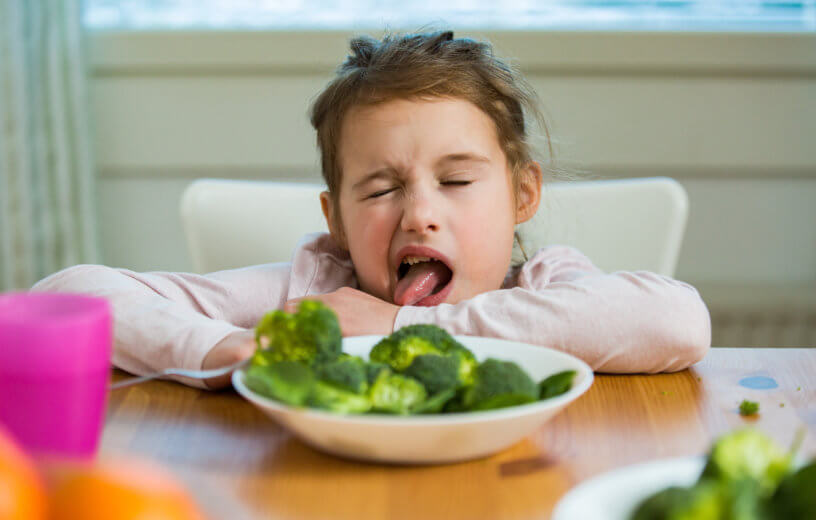UNIVERSITY PARK, Pa. — Kids and vegetables have never been a particularly happy pairing. Even former President George H.W. Bush took his childhood hatred of broccoli into the White House and refused to eat them! Now, however, a new study finds if parents want their children to eat more vegetables, they need to “double down” at dinner time. Researchers from Penn State say literally putting more vegetables on a child’s plate results in them eating more vegetables.
Study authors found that doubling the amount of corn or broccoli served with a meal – going from 60 to 120 grams – led to children eating 68 percent more vegetables overall. That’s about 21 more grams of nutritious veggies in each meal.
When it comes to a child’s nutrition, every gram counts. According to the U.S. Departments of Agriculture and Health and Human Services, experts recommend that kids consume about 1.5 cups of vegetables each day.
“The increase we observed is equal to about one third of a serving or 12% of the daily recommended intake for young children,” says Hanim Diktas, a graduate student in nutritional sciences, in a media release. “Using this strategy may be useful to parents, caregivers and teachers who are trying to encourage kids to eat the recommended amount of vegetables throughout the day.”
Most kids are falling short of nutritional guidelines
Barbara Rolls, the director of Penn State’s Laboratory for the Study of Human Ingestive Behavior, says their findings back up the Department of Agriculture’s “MyPlate” guidance for a healthy diet. MyPlate is the modern version of the classic food pyramid most parents probably grew up seeing. However, the new system shifts more focus to eating fruits and vegetables, along with grains, protein, and dairy.
“It’s important to serve your kids a lot of vegetables, but it’s also important to serve them ones they like because they have to compete with the other foods on the plate,” Rolls says. “Parents can ease into this by gradually exposing kids to new vegetables, cooking them in a way their child enjoys, and experimenting with different flavors and seasonings as you familiarize them.”
Unfortunately, researchers find the majority of U.S. children don’t meet daily goals for fruit and vegetable consumption. They say a lot of this may have to do with kids generally disliking veggies.
Eating veggies is all about what you’re pairing them with
Although the “portion size effect” has actually led to children eating less vegetables in past studies, researchers say they kept the portions of everything else on the plate the same in their experiment. The team also believes what you pair vegetables with plays a major role in how appealing they are to children.
In this case, study authors served 67 children between three and five years-old lunches which included fish sticks, rice, applesauce, and milk.
“We chose foods that were generally well-liked but also not the kids’ favorite foods,” Rolls explains. “If you offer vegetables alongside, say, chicken nuggets you might be disappointed. Food pairings are something you need to be conscious of, because how palpable the vegetables are compared to the other foods on the plate is going to affect the response to portion size. You need to make sure your vegetables taste pretty good compared to the other foods.”
Once a week over four weeks, the team served these lunches along with four differently prepared portions of vegetables. These included a regular serving of plain corn and broccoli, a regular serving seasoned with butter and salt, a double serving of plain corn and broccoli, and a double serving with added butter and salt.
Results show that serving kids more vegetables with these foods led to the children eating more vegetables overall. Surprisingly, adding butter and salt did not make the veggies more attractive to the children. Overall, 76 percent of the children ranked their vegetables anywhere from “yummy” to “just ok.”
Is there anything else to eat?
While butter and salt didn’t seem to play a role in this study, researchers say they could still help introduce children to other greens they’re less familiar with.
“We were surprised that the butter and salt weren’t needed to improve intake, but the vegetables we served were corn and broccoli, which may have been already familiar to and well-liked by the kids,” Diktas says. “So for less familiar vegetables, it’s possible some extra flavoring might help to increase intake.”
Regardless of how hard parents try, there will no doubt be some kids who will never enjoy eating their vegetables. With that in mind, the Penn State is also looking into foods that could be vegetable substitutes in the future.
“We’re working on additional research that looks into substituting vegetables for other food instead of just adding more vegetables,” Diktas concludes. “In the future, we may be able to give recommendations about portion size and substituting vegetables for other foods, so we can both limit waste and promote veggie intake in children.”
The study appears in the journal Appetite.
